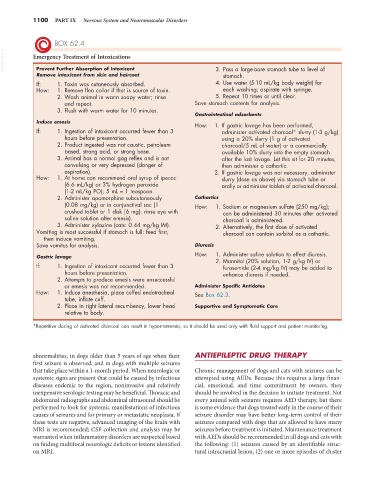Page 1128 - Small Animal Internal Medicine, 6th Edition
P. 1128
1100 PART IX Nervous System and Neuromuscular Disorders
BOX 62.4
VetBooks.ir Emergency Treatment of Intoxications
Prevent Further Absorption of Intoxicant
Remove intoxicant from skin and haircoat 3. Pass a large-bore stomach tube to level of
stomach.
If: 1. Toxin was cutaneously absorbed. 4. Use water (5-10 mL/kg body weight) for
How: 1. Remove flea collar if that is source of toxin. each washing; aspirate with syringe.
2. Wash animal in warm soapy water; rinse 5. Repeat 10 times or until clear.
and repeat. Save stomach contents for analysis.
3. Flush with warm water for 10 minutes.
Gastrointestinal adsorbents
Induce emesis
How: 1. If gastric lavage has been performed,
If: 1. Ingestion of intoxicant occurred fewer than 3 administer activated charcoal* slurry (1-3 g/kg)
hours before presentation. using a 20% slurry (1 g of activated
2. Product ingested was not caustic, petroleum charcoal/5 mL of water) or a commercially
based, strong acid, or strong base. available 10% slurry into the empty stomach
3. Animal has a normal gag reflex and is not after the last lavage. Let this sit for 20 minutes,
convulsing or very depressed (danger of then administer a cathartic.
aspiration). 2. If gastric lavage was not necessary, administer
How: 1. At home can recommend oral syrup of ipecac slurry (dose as above) via stomach tube or
(6.6 mL/kg) or 3% hydrogen peroxide orally or administer tablets of activated charcoal.
(1-2 mL/kg PO); 5 mL = 1 teaspoon.
2. Administer apomorphine subcutaneously Cathartics
(0.08 mg/kg) or in conjunctival sac (1 How: 1. Sodium or magnesium sulfate (250 mg/kg);
crushed tablet or 1 disk [6 mg]: rinse eye with can be administered 30 minutes after activated
saline solution after emesis). charcoal is administered.
3. Administer xylazine (cats: 0.44 mg/kg IM). 2. Alternatively, the first dose of activated
Vomiting is most successful if stomach is full: feed first, charcoal can contain sorbitol as a cathartic.
then induce vomiting.
Save vomitus for analysis. Diuresis
How: 1. Administer saline solution to effect diuresis.
Gastric lavage
2. Mannitol (20% solution, 1-2 g/kg IV) or
If: 1. Ingestion of intoxicant occurred fewer than 3 furosemide (2-4 mg/kg IV) may be added to
hours before presentation. enhance diuresis if needed.
2. Attempts to produce emesis were unsuccessful
or emesis was not recommended. Administer Specific Antidotes
How: 1. Induce anesthesia, place cuffed endotracheal See Box 62.3.
tube, inflate cuff.
2. Place in right lateral recumbency, lower head Supportive and Symptomatic Care
relative to body.
*Repetitive dosing of activated charcoal can result in hypernatremia, so it should be used only with fluid support and patient monitoring.
abnormalities, in dogs older than 5 years of age when their ANTIEPILEPTIC DRUG THERAPY
first seizure is observed, and in dogs with multiple seizures
that take place within a 1-month period. When neurologic or Chronic management of dogs and cats with seizures can be
systemic signs are present that could be caused by infectious attempted using AEDs. Because this requires a large finan-
diseases endemic to the region, noninvasive and relatively cial, emotional, and time commitment by owners, they
inexpensive serologic testing may be beneficial. Thoracic and should be involved in the decision to initiate treatment. Not
abdominal radiographs and abdominal ultrasound should be every animal with seizures requires AED therapy, but there
performed to look for systemic manifestations of infectious is some evidence that dogs treated early in the course of their
causes of seizures and for primary or metastatic neoplasia. If seizure disorder may have better long-term control of their
these tests are negative, advanced imaging of the brain with seizures compared with dogs that are allowed to have many
MRI is recommended; CSF collection and analysis may be seizures before treatment is initiated. Maintenance treatment
warranted when inflammatory disorders are suspected based with AEDs should be recommended in all dogs and cats with
on finding multifocal neurologic deficits or lesions identified the following: (1) seizures caused by an identifiable struc-
on MRI. tural intracranial lesion, (2) one or more episodes of cluster

